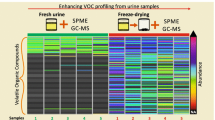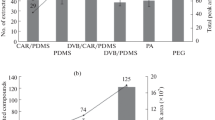Abstract
The natural carbon isotopic composition of acetone in urine was measured in healthy subjects using gas chromatography–combustion–isotope ratio mass spectrometry combined with headspace solid-phase microextraction (HS-SPME–GC–C–IRMS). Before applying the technique to a urine sample, we optimized the measurement conditions of HS-SPME–GC–C–IRMS using aqueous solutions of commercial acetone reagents. The optimization enabled us to determine the carbon isotopic compositions within ±0.2 ‰ of precision and ±0.3‰ of error using 0.05 or 0.2 mL of aqueous solutions with acetone concentrations of 0.3–121 mg/L. For several days, we monitored the carbon isotopic compositions and concentrations of acetone in urine from three subjects who lived a daily life with no restrictions. We also monitored one subject for 3 days including a fasting period of 24 h. These results suggest that changes in the availability of glucose in the liver are reflected in changes in the carbon isotopic compositions of urine acetone. Results demonstrate that carbon isotopic measurement of metabolites in human biological samples at natural abundance levels has great potential as a tool for detecting metabolic changes caused by changes in physiological states and disease.

The natural carbon isotopic composition of acetone in urine can be determined using HS-SPME-GCC-IRMS and can provide information on changes in the availability of glucose in the liver.









Similar content being viewed by others
References
Pauling L, Robinson AB, Teranishi R, Cary P. Quantitative analysis of urine vapor and breath by gas–liquid partition chromatography. Proc Natl Acad Sci U S A. 1971;68:2374–6.
Phillips M, Herrera J, Krishnan S, Zain M, Greenberg J, Cataneo RN. Variation in volatile organic compounds in the breath of normal humans. J Chromatogr B. 1999;729:75–88.
Mills GA, Walker V. Headspace solid-phase microextraction profiling of volatile compounds in urine: application to metabolic investigations. J Chromatogr B. 2001;753:259–68.
Miekisch W, Schubert JK, Noeldge-Schomburg GFE. Diagnostic potential of breath analysis—focus on volatile organic compounds. Clin Chim Acta. 2004;347:25–39.
Buszewski B, Kesy M, Ligor T, Amann A. Human exhaled air analytics: biomarkers of diseases. Biomed Chromatogr. 2007;21:553–66.
Shirasu M, Touhara K. The scent of disease: volatile organic compounds of the human body related to disease and disorder. J Biochem. 2011;150:257–66.
Kataoka H, Saito K, Kato H, Masuda K. Noninvasive analysis of volatile biomarkers in human emanations for health and early disease diagnosis. Bioanalysis. 2013;5:1443–59.
Henderson MJ, Karger BA, Wrenshall GA. Acetone in the breath—a study of acetone exhalation in diabetic and nondiabetic human subjects. Diabetes. 1952;1:188–193&200.
Rooth G, Östenson S. Acetone in alveolar air, and the control of diabetes. Lancet. 1966;288:1102–5.
Tassopoulos CN, Barnett D, Fraser TR. Breath-acetone and blood-sugar measurements in diabetes. Lancet. 1969;293:1282–6.
Crofford OB, Mallard RE, Winton RE, Rogers NL, Jackson JC, Keller U. Acetone in breath and blood. Trans Am Clin Climatol Assoc. 1977;88:128–39.
Kundu SK, Bruzek JA, Nair R, Judilla AM. Breath acetone analyzer: diagnostic tool to monitor dietary fat loss. Clin Chem. 1993;39:87–92.
Laffel L. Ketone bodies: a review of physiology, pathophysiology and application of monitoring to diabetes. Diabetes Metab Res. 1999;15:412–26.
Mitchell GA, Kassovska-Bratinova S, Boukaftane Y, Robert MF, Wang SP, Ashmarina L, et al. Medical aspects of ketone body metabolism. Clin Invest Med. 1995;18:193–216.
Guthrie JP, Jordan F. Amine-catalyzed decarboxylation of acetoacetic acid. The rate constant for decarboxylation of a β-imino acid. J Am Chem Soc. 1972;94:9136–41.
Widmark EMP. Studies in the acetone concentration in blood, urine, and alveolar air. II: The passage of acetone and aceto-acetic acid into the urine. Biochem J. 1920;14:364–78.
Widmark EMP. Studies in the acetone concentration in blood, urine, and alveolar air. III: The elimination of acetone through the lungs. Biochem J. 1920;14:379–94.
Jones AW. Breath-acetone concentrations in fasting healthy men: response of infrared breath-alcohol analyzers. J Anal Toxicol. 1987;11:67–9.
Statheropoulos M, Agapiou A, Georgiadou A. Analysis of expired air of fasting male monks at Mount Athos. J Chromatogr B. 2006;832:274–9.
Ueta I, Saito Y, Hosoe M, Okamoto M, Ohkita H, Shirai S, et al. Breath acetone analysis with miniaturized sample preparation device: in-needle preconcentration and subsequent determination by gas chromatography-mass spectroscopy. J Chromatogr B. 2009;877:2551–6.
Deng CH, Zhang J, Yu XF, Zhang W, Zhang XM. Determination of acetone in human breath by gas chromatography–mass spectrometry and solid-phase microextraction with on-fiber derivatization. J Chromatogr B. 2004;810:269–75.
Wang C, Surampudi AB. An acetone breath analyzer using cavity ringdown spectroscopy: an initial test with human subjects under various situations. Meas Sci Technol. 2008;19:105604.
Wang C, Mbi A, Shepherd M. A study on breath acetone in diabetic patients using a cavity ringdown breath analyzer: exploring correlations of breath acetone with blood glucose and glycohemoglobin A1C. IEEE Sensors J. 2010;10:54–63.
Fan GT, Yang CL, Lin CH, Chen CC, Shih CH. Applications of Hadamard transform-gas chromatography/mass spectrometry to the detection of acetone in healthy human and diabetes mellitus patient breath. Talanta. 2014;120:386–90.
Reyes-Reyes A, Horsten RC, Urbach HP, Bhattacharya N. Study of the exhaled acetone in type 1 diabetes using quantum cascade laser spectroscopy. Anal Chem. 2015;87:507–12.
Storer M, Dummer J, Lunt H, Scotter J, McCartin F, Cook J, et al. Measurement of breath acetone concentrations by selected ion flow tube mass spectrometry in type 2 diabetes. J Breath Res. 2011;5:046011.
Španěl P, Dryahina K, Smith D. Acetone, ammonia and hydrogen cyanide in exhaled breath of several volunteers aged 4–83 years. J Breath Res. 2007;1:011001.
Senthilmohan ST, Milligan DB, McEwan MJ, Freeman CG, Wilson PF. Quantitative analysis of trace gases of breath during exercise using the new SIFT-MS technique. Redox Rep. 2000;5:151–3.
Lord H, Yu YF, Segal A, Pawliszyn J. Breath analysis and monitoring by membrane extraction with sorbent interface. Anal Chem. 2002;74:5650–7.
Musa-Veloso K, Likhodii SS, Cunnane SC. Breath acetone is a reliable indicator of ketosis in adults consuming ketogenic meals. Am J Clin Nutr. 2002;76:65–70.
Teshima N, Li JZ, Toda K, Dasgupta PK. Determination of acetone in breath. Anal Chim Acta. 2005;535:189–99.
Turner C, Španěl P, Smith D. A longitudinal study of methanol in the exhaled breath of 30 healthy volunteers using selected ion flow tube mass spectrometry, SIFT-MS. Physiol Meas. 2006;27:321–37.
Wang TS, Pysanenko A, Dryahina K, Španěl P, Smith D. Analysis of breath, exhaled via the mouth and nose, and the air in the oral cavity. J Breath Res. 2008;2:037013.
Španěl P, Dryahina K, Rejšková A, Chippendale TWE, Smith D. Breath acetone concentration; biological variability and the influence of diet. Physiol Meas. 2011;32:N23–31.
Hayes JM. Fractionation of carbon and hydrogen isotopes in biosynthetic processes. Rev Mineral Geochem. 2001;43:225–77.
Tcherkez G, Mahé A, Hodges M. 12C/13C fractionations in plant primary metabolism. Trends Plant Sci. 2011;16:499–506.
DeNiro MJ, Epstein S. Mechanism of carbon isotope fractionation associated with lipid synthesis. Science. 1977;197:261–3.
Blair N, Leu A, Muñoz E, Olsen J, Kwong E, Des Marais D. Carbon isotopic fractionation in heterotrophic microbial metabolism. Appl Environ Microbiol. 1985;50:996–1001.
Rossmann A, Butzenlechner M, Schmidt HL. Evidence for a nonstatistical carbon isotope distribution in natural glucose. Plant Physiol. 1991;96:609–14.
Rohmer M, Knani M, Simonin P, Sutter B, Sahm H. Isoprenoid biosynthesis in bacteria: a novel pathway for the early steps leading to isopentenyl diphosphate. Biochem J. 1993;295:517–24.
Godin JP, Ross AB, Cléroux M, Pouteau E, Montoliu I, Moser M, et al. Natural carbon isotope abundance of plasma metabolites and liver tissue differs between diabetic and non-diabetic Zucker Diabetic Fatty rats. Plos One. 2013;8:e74866.
Yamada K, Hattori R, Ito Y, Shibata H, Yoshida N. Carbon isotopic signatures of methanol and acetaldehyde emitted from biomass burning source. Geophys Res Lett. 2009;36:L18807.
Yamada K, Hattori R, Ito Y, Shibata H, Yoshida N. Determination of carbon isotope ratios of methanol and acetaldehyde in air samples by gas chromatography-isotope ratio mass spectrometry combined with headspace solid-phase microextraction. Isot Environ Healt Stud. 2010;46:392–9.
Hattori R, Yamada K, Hasegawa K, Ishikawa Y, Ito Y, Sakamoto Y, et al. An improved method for the measurement of the isotope ratio of ethanol in various samples, including alcoholic and non-alcoholic beverages. Rapid Commun Mass Spectrom. 2008;22:3410–4.
Hattori R, Yamada K, Shibata H, Hirano S, Tajima O, Yoshida N. Measurement of the isotope ratio of acetic acid in vinegar by HS-SPME-GC-TC/C-IRMS. J Agric Food Chem. 2010;58:7115–8.
Coplen TB, Brand WA, Gehre M, Gröning M, Meijer HAJ, Toman B, et al. New guidelines for δ13C measurement. Anal Chem. 2006;78:2439–41.
Tayasu I, Hirasawa R, Ogawa NO, Ohkouchi N, Yamada K. New organic reference materials for carbon- and nitrogen-stable isotope ratio measurements provided by Center for Ecological Research, Kyoto University, and Institute of Biogeosciences, Japan Agency for Marine-Earth Science and Technology. Limnology. 2011;12:261–6.
Huang DS, Wu SH, Huang CY, Lin CY. An exploration of intramolecular carbon isotopic distributions of commercial acetone and isopropanol. Org Geochem. 1999;30:667–74.
Felby S, Nielsen E. Determination of ketone bodies in postmortem blood by head-space gas chromatography. Forensic Sci Int. 1994;64:83–8.
Kobayashi K, Okada M, Yasuda Y, Kawai S. A gas chromatographic method for the determination of acetone and acetoacetic acid in urine. Clin Chim Acta. 1983;133:223–6.
Kawai T, Yasugi T, Horiguchi S, Uchida Y, Iwami O, Iguchi H, et al. Biological monitoring of occupational exposure to isopropyl alcohol vapor by urinalysis for acetone. Int Arch Occup Environ Health. 1990;62:409–13.
Kawai T, Yasugi T, Mizunuma K, Horiguchi S, Iguchi H, Ikeda M. Curvi-linear relation between acetone in breathing zone air and acetone in urine among workers exposed to acetone vapor. Toxicol Lett. 1992;62:85–91.
Satoh T, Omae K, Takebayashi T, Nakashima H, Higashi T, Sakurai H. Acetone excretion into urine of workers exposed to acetone in acetate fiber plants. Int Arch Occup Environ Health. 1995;67:131–4.
Ghittori S, Maestri L, Maraccini P, Imbriani M. Acetone in urine as biological index of occupational exposure to isopropyl alcohol. Ind Health. 1996;34:409–14.
Garrido-Delgado R, Arce L, Pérez-Marín CC, Valcárcel M. Use of ion mobility spectroscopy with an ultraviolet ionization source as a vanguard screening system for the detection and determination of acetone in urine as a biomarker for cow and human diseases. Talanta. 2009;78:863–8.
Pysanenko A, Wang T, Španěl P, Smith D. Acetone, butanone, pentanone, hexanone and heptanone in the headspace of aqueous solution and urine studied by selected ion flow tube mass spectrometry. Rapid Commun Mass Spectrom. 2009;23:1097–104.
Acknowledgments
K.Y., A.G., and N.Y. thank the Grant-in-Aid for Scientific Research (S) (23224013), MEXT, Japan, for financial support.
Author information
Authors and Affiliations
Corresponding author
Ethics declarations
Conflict of interest
The authors declare that they have no competing interests.
Informed consent
Informed consent was obtained from all the subjects in this study.
Rights and permissions
About this article
Cite this article
Yamada, K., Ohishi, K., Gilbert, A. et al. Measurement of natural carbon isotopic composition of acetone in human urine. Anal Bioanal Chem 408, 1597–1607 (2016). https://doi.org/10.1007/s00216-015-9268-z
Received:
Revised:
Accepted:
Published:
Issue Date:
DOI: https://doi.org/10.1007/s00216-015-9268-z




